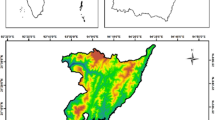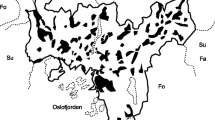Abstract
In mountainous areas, the landscape spatial pattern is affected by topography and human activities. To better understand topographic influences on the vegetation structure in the landscape mosaic and interpret the ecological implications of spatial patterns, the relationships between topographic features and landscape pattern indices (LPIs) should be addressed. The objective of this study is to address the effects of topography on LPIs (both planimetric and surface LPIs) by integrating spatial analysis and gradient analysis. To fulfill these objectives, two different mountain research sites located in the Lancang River watershed were chosen, both planimetric and surface landscape metrics were used to quantify natural category (NC) and anthropogenic category (AC) patterns, and the redundancy ordination gradient method was used to address the relationship between LPIs (planimetric and surface metrics) of NC and AC patterns and topographic attributes. The results suggest that topographic attributes play a prominent role in structuring the landscape mosaic. Elevation is a key factor for NC and AC patch patterns in the study area. The results indicate that the fragmentation and isolation of NC patterns increase as elevation decreases. In contrast, the fragmentation and isolation of AC patterns decrease as elevation decreases.
Similar content being viewed by others
References
Allen TR, Walsh SJ (1996) Spatial and compositional pattern of alpine treeline, Glacier National Park, Montana. Photogramm Eng Rem S 62:1261–1268
Anderson DM, Salick J, Moseley RK, Ou X (2005) Conserving the sacred medicine mountains: a vegetation analysis of Tibetan sacred sites in Northern Yunnan. Biodivers Conserv 14:3065–3091
Arnot C, Fisher PF, Wadsworth R, Wellens J (2004) Landscape metrics with ecotones: pattern under uncertainty. Landsc Ecol 19:181–195
Bailey RG (1996) Ecosystem geography. Springer, New York
Brown DG (1994) Predicting vegetation types at treeline using topographic and biophysical disturbance variables. J Veg Sci 5:641–656
Bürgi M, Hersperger AM, Schneeberger N (2004) Driving forces of landscape change—current and new directions. Landsc Ecol 19:857–868
Crave E, Gascuel-Odoux C (1997) The influence of topography on time and space distribution of soil surface water content. Hydrol Process 11:203–210
De Clercq EM, Vandemoortele F, De Wulf RR (2006) A method for the selection of relevant pattern indices for monitoring of spatial forest cover pattern at a regional scale. Int J Appl Earth Obs 8:113–125
Dorner B, Lertzman K, Fall J (2002) Landscape pattern in topographically complex landscapes: issues and techniques for analysis. Landsc Ecol 17:729–743
Eastman JR (2006) Idrisi Andes user’s manual. Clark Labs, Clark University, Worcester
Farina A (2006) Principles and methods in landscape ecology, 3rd edn. Springer, Dordrecht, the Netherlands
Forman RTT (1995) Land Mosaics: The ecology of landscapes and regions. Cambridge University Press, Cambridge, UK
Frazier AE (2016) Surface metrics: scaling relationships and downscaling behavior. Landsc Ecol 31:351–363
Frazier AE, Wang L (2013) Modeling landscape structure response across a gradient of land cover intensity. Landsc Ecol 28:233–246
Fu B, Jones KB (2013) Landscape ecology for sustainable environment and culture. Springer, New York
Garbarino M, Lingua E, Weisberg PJ, Bottero A, Meloni F, Motta R (2013) Land-use history and topographic gradients as driving factors of subalpine Larix decidua forests. Landsc Ecol 28:805–817
Gardner RH (1999) RULE: map generation and a spatial analysis program. Springer, New York
Gómez-Plaza A, Martı´nez-Mena M, Alvadalejo J, Castillo VM (2001) Factors regulating spatial distribution of soil water content in small semiarid catchments. J Hydrol 253:211–226
Gulinck H, Mugica M, de Lucio J, Atauri J (2001) A framework for comparative landscape analysis and evaluation based on land cover data, with an application in the Madrid region (Spain). Landsc Urban Plan 55:257–270
Hoechstetter S, Thinh NX, Walz U (2006) 3D-indices for the analysis of spatial pattern of landscape structure. In: Proceedings of the 12th InterCarto-InterGIS, Berlin, 2006, pp 108–118
Hoechstetter S, Walz U, Dang LH, Thinh NX (2008) Effects of topography and surface roughness in analyses of landscape structure—a proposal to modify the existing set of landscape metrics. Landsc Onl 3:1–14
Hörsch B (2003) Modeling the spatial distribution of montane and subalpine forests in the central Alps using digital elevation models. Ecol Model 168:267–282
Hufkens K, Ceulemans R, Scheunders P (2008) Estimating the ecotone width in patchy ecotones using a sigmoid wave approach. Ecol Inform 3:97–104
Jenness JS (2004) Calculating landscape surface area from digital elevation models. Wildlife Soc B 32:829–839
Jenness JS (2008) Surface tools (surf_tools.avx) extension for ArcView 3.x, v. 1.6b. Jenness Enterprises. Available at: http://www.jennessent.com/arcview/surface_tools.htm. Accessed 19 Feb 2009
Legendre P, Legendre L (1998) Numerical ecology, vol 2. Elsevier, Amsterdam
Leps J, Smilauer P (2003) Multivariate analysis of ecological data using CANOCO. Cambridge University Press, London
Li H, Wu J (2004) Use and misuse of landscape indices. Landsc Ecol 19:389–399
Li H, Ma Y, Liu W, Liu W-J (2009) Clearance and fragmentation of tropical rainforest in Xishuangbanna, SW China. Biodivers Conserv 18:3421–3440
Liu W, Hu H, Ma Y, Li H (2006) Environmental and socioeconomic impacts of increasing rubber plantation in Menglun Township, southwest China. Mt Res Dev 26(3):245–253
McGarigal K, Cushman SA (2005) The gradient concept of landscape structure. In: Wiens J, Moss M (eds) Issues and perspectives in landscape ecology. Cambridge University Press, London, pp 112–119
McGarigal K, Tagil S, Cushman SA (2009) Surface metrics: an alternative to patch metrics for the quantification of landscape structure. Landsc Ecol 24:433–450
McGarigal K, Cushman SA, Ene E (2012) FRAGSTATS: spatial pattern analysis program for categorical maps. University of Massachusetts, Amherst. http://www.umass.edu/landeco/research/fragstats/fragstats.html. Accessed 29 Nov 2016
Moore ID, Grayson RB, Ladson AR (1991) Digital terrain modeling: a review of hydrological, geomorphological, and biological application. Hydrol Process 5:3–30
O’Neill RV, Hunsaker CT, Timmins SP, Jackson BL, Jones KB, Riitters KH, Wickham JD (1996) Scale problems in reporting landscape pattern at the regional scale. Landsc Ecol 11:169–180
Okland RH (1999) On the variation explained by ordination and constrained ordination axes. J Veg Sci 10:131–136
Parker AJ (1989) Forest/environment relationship in Yosemite National Park, Califonia. Vegetatio 82:41–54
Parker AJ (1995) Comparative gradient structure and forest cover types in Lassen Volcanic and Yosemite National Parks, California. Bull Torrey Bot Club 122:58–68
Peng J, Wang Y, Zhang Y, Wu J, Li W, Li Y (2010) Evaluating the effectiveness of landscape metrics in quantifying spatial patterns. Ecol Indi 10:217–223
Pinder JE, Kroh GC, White JD, Basham May AM (1997) The relationship between vegetation types and topography in Lassen Volcanic National Park. Plant Ecol 131:17–29
Riitters KH, O’Neill RV, Hunsacker CT, Wickham JD, Yankee DH, Timmins SP, Jones KB, Jackson BL (1995) A factor analysis of landscape pattern and structure metrics. Landsc Ecol 10:23–39
Roth NE, Allan JD, Erickson DL (1996) Landscape influence on stream biotic integrity assessed at multiple spatial scales. Landsc Ecol 11:141–156
Salick J, Amend A, Anderson D, Hoffmeister K, Gunn B, Fang Z (2007) Tibetan sacred sites conserve old growth trees and cover in the eastern Himalayas. Biodivers Conserv 1:693–706
Saura S, Martinez-Millan J (2000) Landscape patterns simulation with a modified random clusters method. Landsc Ecol 15:661–678
Shen Z (2002) A multi-scale study on the vegetation-environment relationship of a mountain forest transect. Acta Ecol Sin 22(4):461–470 (in Chinese)
Shen Z, Zhang X (2000) The spatial pattern and topographic interpretation of the forest vegetation at Dalaoling Region in the Three Gorges. Acta Bot Sin 42:1089–1095 (in Chinese)
Sherman R, Mullen R, Li H, Fang ZD, Wang Y (2008) Spatial patterns of plant diversity and communities in alpine ecosystems of the Hengduan Mountains, northwest Yunnan, China. Plant Ecol 1:117–136
Swanson FJ, Wondzell SM, Grant GE (1992) Landforms, disturbance, and ecotones. In: Hansen AJ, di Castri F (eds) Landscape boundaries: consequences for biotic diversity and ecological flows. Springer, New York, pp 304–323
Swanson FJ, Kratz TK, Caine N, Woodmansee RG (1998) Landform effects on ecosystem patterns and processes. Bioscience 38:92–98
Ter Braak CJF, Šmilauer P (2002) CANOCO reference manual and CanoDraw for Windows user’s guide: software for canonical community ordination (version 4.5). Microcomputer Power, Ithaca, p 500
Turner MG (1989) Landscape ecology: the effect of pattern on process. Annu Rev Ecol Syst 20:171–197
Turner MG, Gardner RH, O’Neill RV (2001) Landscape ecology in theory and practice. Springer, New York, pp 93–134
Van Den Hoek J, Ozdogan M, Burnicki AC, Zhu AX (2014) Evaluating forest policy implementation effectiveness with a cross-scale remote sensing analysis in a priority conservation area of Southwest China. Appl Geogr 47:177–189
Van Den Hoek J, Burnicki AC, Ozdogan M, Zhu AX (2015) Using a pattern metric-based analysis to examine the success of forest policy implementation in Southwest China. Landsc Ecol 30:1–17
Wang D (2006) Research and implementation of construction of 1:50,000 scale topographic database in China. Geomat World 4:4–5 (in Chinese)
Wang S, Van Kooten C, Wilson B (2004) Mosaic of reform: forest policy in post-1978 China. For Policy Econ 6:71–83
Wei X, Xiao Z, Li Q, Li P, Xiang C (2016) Evaluating the effectiveness of landscape configuration metrics from landscape composition metrics. Landsc Ecol Eng. doi:10.1007/s11355-016-0314-6
Western AW, Grayson RB, Blöschl G, Willgoose GR, McMahon TA (1999) Observed spatial organization of soil moisture and its relation to terrain indices. Water Resour Res 35:797–810
Weyerhaeuser H, Wilkes A, Kahrl F (2005) Local impacts and response to regional forest conservation and rehabilitation programs in China’s northwest Yunnan Province. Agric Syst 85:234–253
Wilson JP, Gallant JC (2000) Terrain analysis principles and applications. Wiley, New York
Wimberly M, Ohmann J (2004) A multi-scale assessment of human and environmental constraints on forest land cover change on the Oregon (USA) coast range. Landsc Ecol 19:631–646
Wondzel SM, Cunningham GL, Bachelet D (1996) Relationships between landforms, geomorphic processes, and plant communities on a watershed in the northern Chihuahuan Desert. Landsc Ecol 11:351–362
Wu J (2004) Effects of changing scale on landscape pattern analysis: scaling relations. Landsc Ecol 19:125–138
Xu J, Wilkes A (2004) Biodiversity impact analysis in northwest Yunnan, southwest China. Biodivers Conserv 13:959–983
Xu J, Fox J, Xing L, Podger N, Leisz S, Ai X (1999) Effects of swidden cultivation, population growth, and state policies on land cover in Yunnan, China. Mt Res Dev 19:123–132
Zhang N, Li H (2013) Sensitivity and effectiveness of landscape metric scalograms in determining the characteristic scale of a hierarchically structured landscape. Landsc Ecol 28:343–363
Zhang Z, Van Coillie F, De Wulf RR, De Clercq EM, Ou X (2012) Comparison of surface and planimetric landscape metrics for mountainous land cover pattern quantification in Lancang Watershed, China. Mt Res Dev 32:213–225
Zhang Z, Van Coillie F, De Clercq EM, Ou X, De Wulf RR (2013) Mountain vegetation change quantification using surface landscape metrics in Lancang Watershed, China. Ecol Indic 31:49–58
Zhang Z, Van Coillie F, Ou X, De Wulf RR (2014) Integration of satellite imagery, topography and human disturbance factors based on canonical correspondence analysis ordination for mountain vegetation mapping: a case study in Yunnan, China. Remote Sens 6:1026–1056
Acknowledgements
This work was supported by grants from the National Natural Science Foundation of China (41361046 and 41261105), and the West Light Foundation of the Chinese Academy of Sciences. We thank Drs. Ulrich Walz and Sebastian Hoechstetter for their comments on this work. We thank our colleagues working in the Laboratory of Forest Management and Spatial Information, Ghent University, Belgium.
Author information
Authors and Affiliations
Corresponding author
Ethics declarations
Conflict of interest
The authors declare that they have no conflict of interest.
Rights and permissions
About this article
Cite this article
Zhang, Z., Zinda, J.A., Yang, Z. et al. Effects of topographic attributes on landscape pattern metrics based on redundancy ordination gradient analysis. Landscape Ecol Eng 14, 67–77 (2018). https://doi.org/10.1007/s11355-016-0322-6
Received:
Revised:
Accepted:
Published:
Issue Date:
DOI: https://doi.org/10.1007/s11355-016-0322-6









